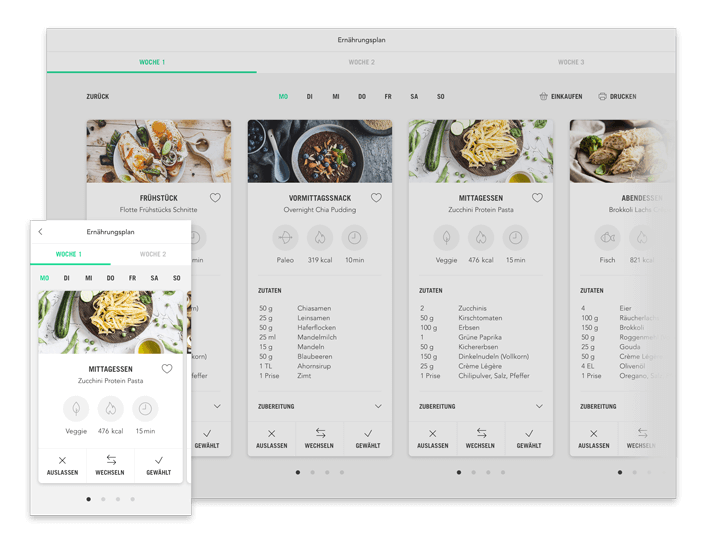Your nutrition plan, which takes into account your intolerance or allergy
An individual meal plan, designed around your intolerances and allergies

The term intolerance refers to the condition whereby the body cannot fully process certain substances ingested through the diet. The most common reason for this is an enzyme deficiency. A lack of enzymes in the stomach can inhibit people from fully processing and digesting substances containing, for example, lactose or fructose. Unpleasant reactions such as cramps and nausea are common consequences of such a deficiency.
1. The difference between an Intolerance and an Allergy
The main difference between an intolerance and an allergy lies in the reaction. A few intolerances are so severe that they illicit a so-called pseudoallergic reaction. These reactions, for example, swelling, breathing problems or skin rashes are caused by the same cells that are responsible for allergic reactions.
The symptoms of most intolerances are caused by a lack of enzymes in the stomach. Typical reactions are nausea, cramps and digestive problems which aren’t life-threatening but can nevertheless limit one’s quality of life. It is fair to say that those with an allergy need to be far more careful with their diet, than those with an intolerance, since the threat to life is much higher with allergies.
1.1 Symptoms of Food Intolerances
Many people don’t even know they have a food intolerance. Their symptoms are chronic and they just learn to live with them. If you experience the following symptoms, then you could have a food intolerance:
Symptom
- Bloated stomach/flatulence
- Digestive problems
- Stomach cramps
- Cravings
- A burning tongue
- A racing heart
- Headaches
- Tiredness/difficulty sleeping
1.2 Histamine Intolerance
A histamine intolerance is a congenital or acquired metabolic disorder that is influenced by environmental factors and bodily components but does not affect the immune system. The affected person is no longer able to maintain the level of histamine at a set point. This means that the body of a person with a histamine intolerance has problems breaking down the body’s enzyme histamine when it is released in bulk from the body’s own storage system. We often get even more histamine from our diets, increasing the excess levels of histamine even further. The allergic reactions or flu-like symptoms are caused as a result of these enzymes not getting broken down in the intestinal flora. People who suffer from a histamine intolerance, often don’t even know they have it and live very long with the problem, without changing their diet and improving their quality of life. Below you will find a selection of foods that should be avoided by those who suffer from a histamine intolerance.
| Food | DIGESTIBILITY* |
|---|---|
| Smoked fish | Red |
| Tinned fish | Red |
| Avocado | Red |
| Pickled cabbage | Red |
| Hard cheese (parmesan) | Red |
| Soft cheese (Brie, Camembert) | Red |
| Sliced cheese (Edam, Gouda) | Red |
| Spinach | Rot |
| Beef | Red |
| Vinegar | Red |
| Wine and sparkling wine | Red |
| Beer | Red |
| Tomatoes | Red |
| Citrus fruits | Orange |
| Fruits (Strawberries, Pineapples, Kiwis, Oranges, Pears, Bananas, Raspberries) | Orange |
| Chocolate | Orange |
| Wheatgerm | Orange |
| Seafood | Orange |
| Mushrooms | Orange |
| Nuts | Orange |
| Pulses | Orange |
1.3 Lactose Intolerance
As the name implies, people with this problem cannot tolerate lactose. Their bodies cannot break down the sugars in milk and consequently cannot digest them. Lactose is composed of glucose and galactose and is therefore considered a disaccharide. For the breakdown of lactose into it’s two respective components, the body requires lactase in the small intestine. The intestinal mucosa can only absorb glucose and galactose and not lactose. A lactose intolerance is therefore caused by a lack of lactase in the small intestine. The body is capable of decomposing milk sugars without lactase, or rather with little lactase, with the help of intestinal bacteria. This decomposition causes the uncomfortable symptoms of an intolerance. The gases, such as hydrogen, carbon dioxide and methane cause symptoms such as stomach bloating, flatulence and stomach cramps.
| Food | Lactose in g / 100g | DIGESTIBILITY* |
|---|---|---|
| Buttermilk | 3.5-4.0 | Red |
| Kefir | 3.5-6.0 | Red |
| Cream/whipped cream | 2.8-3.6 | Red |
| Creme Fraiche | 2.0-3.6 | Red |
| Butter | 0.6-0.7 | Orange |
| Whey | 2.0-5.2 | Red |
| Quark | 2.0-3.8 | Red |
| Cheese spread | 2.8-6.3 | Red |
| Ready made deserts | 3.3-6.3 | Red |
| Ice cream | 5.1-6.9 | Red |
| Cream cheese | 2.0-3.8 | Red |
| Cottage cheese | 2.6 | Red |
| Joghurt | 3.5-6.0 | Red |
| Coffee cream | 3.8-4.0 | Red |
| Condensed milk | 9.3-12.5 | Red |
| Low-fat quark | 4.1 | Red |
| Goat’s milk | 4.0-4.2 | Red |
| Sheep’s milk | 4.4-4.7 | Red |
| Cow’s milk | 4.7 | Red |
| Milk powder | 38.0-51.5 | Red |
| Other cheese products | 0-0.4 | Orange |
1.4 Fructose Intolerance
Similarly to lactose, those with a fructose intolerance have a problem digesting the monosaccharide fructose. Fructose is used in energy production and fat storage. However, we don’t need to get fructose from food, since our bodies can convert glucose into fructose. We need to distinguish between three different types of fructose intolerances.
Fructosemia or fructosuria is an intolerance, which is usually only diagnosed incidentally and doesn’t require intervention. The absence of fructokinase, an enzyme of the liver, can cause an accumulation of fructose in the blood (fructosemia) and urine (fructosurie).
When we talk non-technically about a fructose intolerance, it generally refers to people who cannot absorb fructose. This is to do with a problem with the transport system in the intestine. However, with the help of bacteria, the human body can also decompose and transport fructose. As with lactose, the common unpleasant symptoms are a result of this decomposition. Gases such as hydrogen, carbon dioxide, and methane cause the symptoms, such as stomach bloating, flatulence and stomach cramps.
The hereditary fructose intolerance is an inherited metabolic disorder and is the most dangerous of the fructose intolerances. It is very rare, with only 1 in 20,000 people suffering from this condition. However, in these rare cases, it needs to be medically treated, because it can lead to poisoning.
| Food | Fructose in g / 100g | Digestibility * |
|---|---|---|
| Apple | 5.7 | Red |
| Pineapple | 2.6 | Orange |
| Watermelon | 3.9 | Red |
| Banana | 3.6 | Red |
| Pear | 6.7 | Red |
| Broad beans | 2.2 | Orange |
| Berries | 1.3-4.1 | Orange-Red |
| Dates/ raisins | 31.3 | Red |
| Grapes | 7.6 | Red |
| Red pepper | 3.7 | Red |
| Grapefruit | 2.5 | Orange |
| Onions | 1,1 | Orange-red |
| Cabbage | 1.9 | Orange |
| Honey | 37.5 | Red |
| Cherries | 6.2 | Red |
| Kiwi | 4.4 | Red |
| Kohlrabi | 1.1 | Orange |
| Squash | 1.6 | Orange |
| Mandarine | 1.3 | Orange |
| Orange | 2.9 | Orange |
| Plum | 2 | Orange |
1.5 Celiac Disease (Gluten intolerance)
Celiac disease is a partly inherited gluten intolerance and displays features of both an allergy and an autoimmune disease. It is a chronic disease of the intestine, which arises from an intolerance to the binding protein gluten, or rather gliadin. Gluten and gliadin are above all present in the cereals spelt, barley, oats and wheat. Those affected are most often advised to cut out gluten completely and to organize their diet accordingly. The consequences of chronic inflammation of the intestinal tract are manifold. Acute symptoms, such as digestive problems, bloating and flatulence are only the beginning. A long term inflammation of the digestive tract can lead to problems with nutrient absorption since the intestine plays a key role in the processing and transport of nutrients. People who suffer from such an allergy need to take action quickly and change their diet before it leads to long term harm.
| Food | Digestibility * |
|---|---|
| Spelt | Red |
| Wheat | Red |
| Beer | Red |
| Barley | Red |
| Rye | Red |
| Oats | Red |
| Semolina | Red |
| Couscous | Red |
| Bulgar | Red |
| Bread/ bread rolls | Red |
| “normal’ pasta | Red |
| Sauces (thickened with wheat) | Red |
| Pizza base | Red |
| Cake | Red |
| Bicuits | Red |
| Rusks | Red |
| Malt | Red |
| Pearl barley | Red |
| Durum wheat | Red |
| Baked goods (waffles, pretzels) | Red |
| Cereal flour | Red |
* Orange = can be tolerated in small quantities, eat occasionally and in small amounts; Red = cannot be tolerated, these should be avoided completely.
2. How does Upfit help you to live with your intolerance?
You thought losing weight with your intolerance was near to impossible, and could only occur if you starved yourself and exercised to the point of exhaustion. We have an alternative for you.
With Upfit, within a matter of minutes, you can put together your own individual nutrition plan tailored around your intolerance. In addition, you can let us know which ingredients you would like to leave out, to ensure you enjoy your new meals as much as possible! Alongside your nutrition plan, our expert nutritionists are there to advise you on how to manage your intolerance.
3. Example day in your Nutrition Plan

We make it easy for you! With our nutrition plan, healthy eating is not only child’s play but also delicious, varied and above all sustainable.
A personalised Nutrition plan for healthy eating helps you take the first step and eventually go the whole distance towards a new you, by telling you exactly what you need to do. From weekly shopping lists for everything you need for your meals, to exact guidelines as to when and how to prepare the tasty and nourishing dishes, right up to tips for planning your life around the goal of health, you will find everything you need. Further details can be seen in the above diagram. Alternatively, you can check out further example functions of the plan here.
Incidentally: did you know that over 90% of Upfit recipes can be prepared in under 20 minutes.
4. Customer testimonials for Upfit

Philippe U.
“Great plans, great service, perfect advice! Thank you! can only recommend further.” [translated]

Tine S.
“I lost 20 kg in 12 weeks. Plans are easy and inexpensive to buy …” [translated]

Anna Y.
“In 8 weeks I was able to lose 5 kg and not once did I have the feeling that I was on a diet.” [translated]

Philipp W.
“Individual, practical, and inexpensive. Especially considering how much is included in your Plan.” [translated]

